Every year, districts across the state are required to identify students who will participate in Gifted and Talented (GT) programs. This GT identification process has specific requirements outlined in the Texas State Plan for the Education of Gifted/Talented Students.
This blog offers checklists and downloadable tools to guide coordinators in ensuring they follow the required components for the identification process. It also discusses the best way to meet programming needs in their district. Let’s jump in and discuss the steps on the checklist.
Step 1: Gather Materials
There are a variety of documents and other resources needed throughout the GT identification process. Make sure that you collect as much of this information as you can. If you cannot locate an item, you may need to develop it or find the resource online.
Materials have been separated into the following categories:
- Reference materials – documents that are for your reference to use as you work through the identification process
- Required materials – resources all districts will be required to use as part of the process.
- Optional materials – resources that some districts may require as part of their custom identification process or resources that you may find beneficial but are not specifically required to complete the process.
Reference Materials
- The Texas State Plan for the Education of Gifted/Talented Students
- District Gifted/Talented Program Manual
- Board Policies: EHBB local and legal
- District Policy for Transfer Students
- District Policy for Reassessment of Students
- Appeals Policy
Required Materials
- Referral Forms
- Assessment/Placement Results Letter for Families
- List of Assessments used for each grade band
- All necessary staff training components for each assessment are listed
- All necessary implementation components for each assessment are listed
- List of assessment options for students that need accommodations (special education, bilingual, etc.)
Optional Materials
- Previous Year’s Communication with Families and Community related to Referral Process
- Previous Year’s Agenda for Awareness Session
- Previous Year’s Assessment Calendar or Schedule
- Placement Committee Materials
- Training Materials used to align selection decisions
- Assessment requirements used by the district (cut scores, matrices, etc.)
- List of Placement Committee members with credentials related to Gifted and Talented program requirements
- Kindergarten Consideration Checklist
- List of Assessments used to identify the areas of “leadership, artistic, and creative areas”
Download the Materials Checklist.
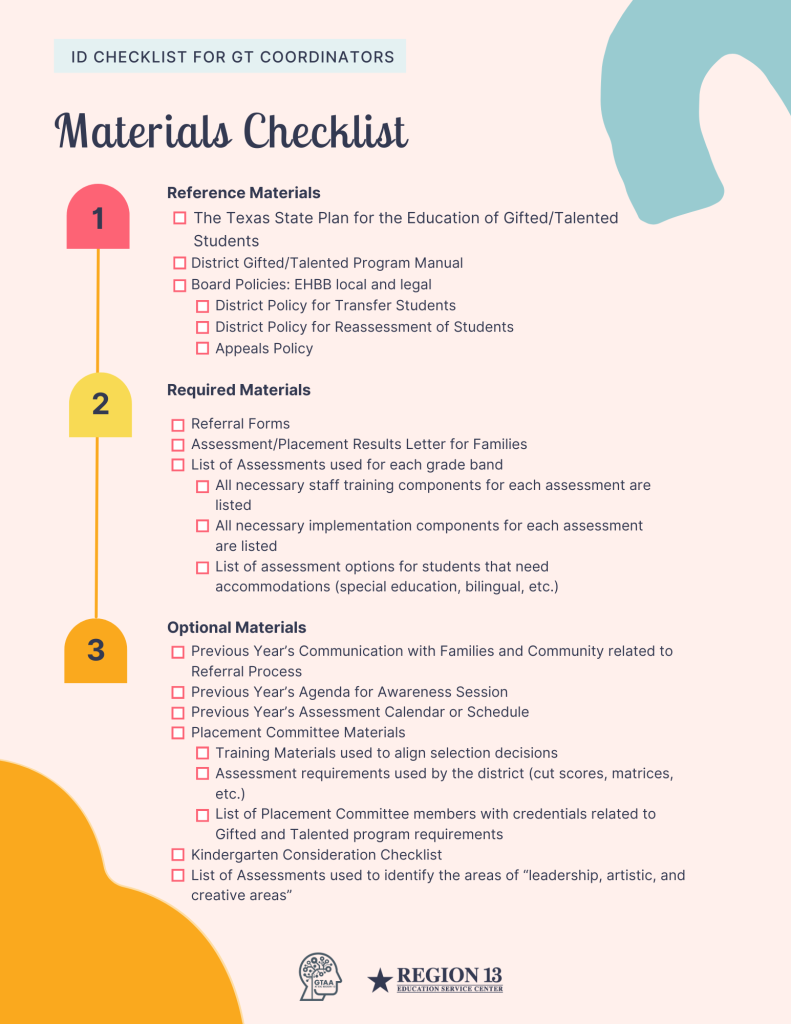
Step 2: Prepare Communication
Before you begin the official GT identification process, it will benefit you to prepare staff and families so that they can participate. You want to confirm that all involved parties are notified when the process begins and communicate details with them that will support the process.
Staff Communication
- Schedule staff communication to go out district-wide describing the identification process. Include verbiage encouraging staff to refer students and list specific campus contacts available to answer staff and parent questions.
- Send out communication to any staff member who has a role in the process to notify them of their expectations during the process. This includes:
- Campus Contact (Administrator or Counselor that oversees campus program)
- Testing Proctors (staff used to implement assessments with students)
- Placement Committee Members
- Train testing proctors
Family Communication
- Post an announcement on the Gifted/Talented page of your website.
- Schedule any other needed communications to go out to families. This may include:
- Additional ads on the district and/or campus websites
- Fliers that go out to parents
- Updates in the district newsletter
- Schedule and Present a Family Awareness Session
- Prepare an overview of the Gifted/Talented program
- Share relevant documents supporting families, including where the district manual is located, a list of campus contacts, referral packets, etc.
Download the Communication Checklist.
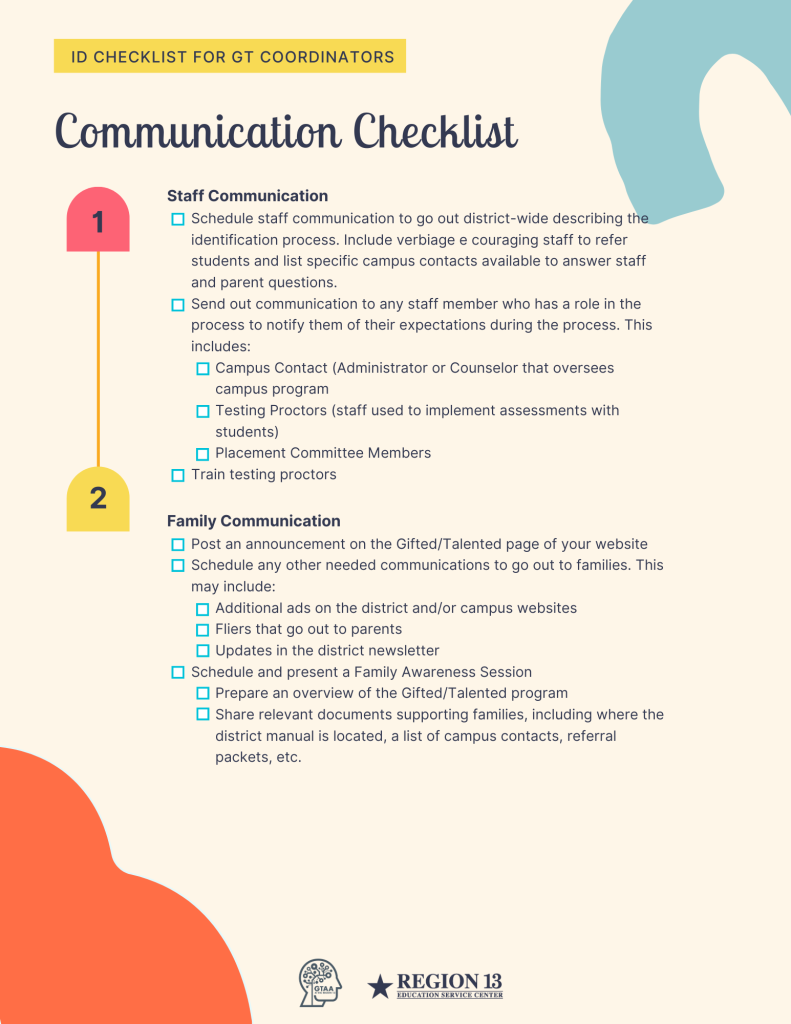
Step 3: Prepare Referrals
Referrals are the first major component of the GT identification process. During this period, you will collect student referrals for assessment from different sources, including staff, families, students, and community members. While collecting referrals, you may also be preparing to assess students (step 4).
Prepare Referral Packets
- Prepare referral packets. Packets may include:
- Permission to Assess Students
- Staff/Parent/Student surveys
- Information related to student portfolio requirements (if applicable)
- Outline of Testing Schedule
- List of Campus Contacts
- For reference, share referral packets with campus coordinators and staff involved in the identification process.
- Post access to packets in a public space, such as a website link, and physical copies on each campus available to families/staff.
Collect Necessary Documents
- Collect “Permission to Assess” documents for all students who are referred.
- Prepare a list of students in each grade level to be assessed, including homeroom teacher information for scheduling purposes.
- Kindergarten Considerations should take place with all kindergarten students. “Considerations” can include the following: Note that students who do not meet these criteria can still be referred for testing.
- Checklists are used by staff with all students to look for characteristics of giftedness.
- Identify students for referral based on their performance on a grade-level norm-based assessment (universal screener, etc.).
Create a Testing Schedule
- Create an outline of the testing schedule that includes:
- Referral window
- Testing dates by grade level or grade band
- Makeup dates for testing
- Placement committee meeting date(s)
- Start date for services
Download the Referral Checklist.
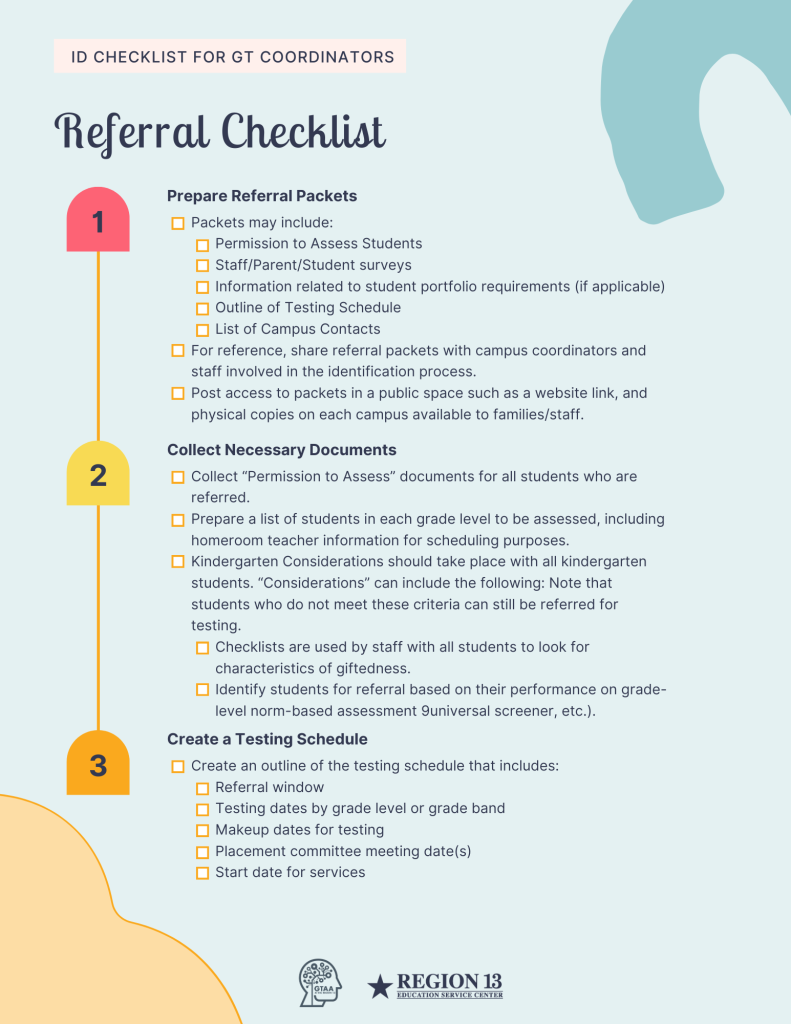
Step 4: Assess Students
This step may overlap with your referral window. During this step, you will begin to assess students using the district-approved assessment materials.
Prior to Assessments
- Schedule specific dates/times for assessments by grade level or grade band.
- Communicate assessment details with all campus coordinators
- Name of staff member proctoring the assessment(s)
- Date/time scheduled
- Students that will be involved, homeroom teacher
- Any materials students need to bring
- Any specific testing procedures (practice tests, written or computerized testing, small group or individual, etc.)
- Scoring information for assessments
- Makeup testing information
During Assessments
- Pull students for assessments
- Note student’s assessment abnormalities (if needed)
- Note students that will participate in makeup test dates
After Assessments
- Score assessments
- Score surveys on a district or vendor-approved rubric
- Collect and score student portfolio items on a district-approved rubric
- Hand-score any other assessments as needed
- Prepare Student Data
- Use a student portfolio or data matrix to record the assessment scores for each student.
- Optionally include additional considerations at the bottom of your portfolio or matrix that identifies:
- Language Needs (EL, Bilingual, ESL)
- Special Education support
- Students from specific populations (Low SES, Migrant, Homeless, etc.)
Download the Assessment Process Checklist.
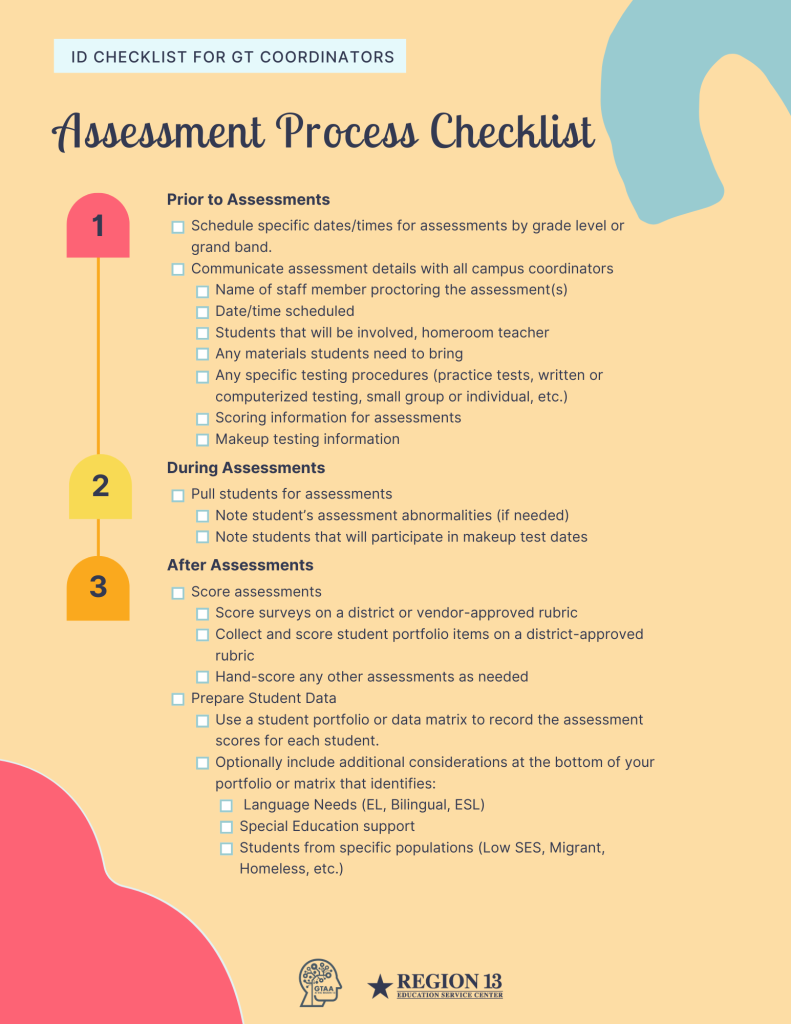
Step 5: Identify Students
During this final period, you will work with the placement committee to identify students for gifted/talented program services. You will also notify staff and families of decisions and prepare for services to begin.
Selection Committee
- Schedule specific dates/times for the placement committee(s) to meet
- Send out information related to scheduled sessions and requirements for staff participation
- Materials to bring to the meeting
- Training materials they should review in advance of the meeting
- Notice of nondisclosure related to assessments and student data
- Prepare Placement Committee Training materials.
- Slides or information related to assessments used and criteria for services
- Slides and examples to set expectations for selection decisions
- Slides to explain requests for “additional assessment information” when the committee cannot come to an agreement or sees a need for further testing
- When multiple committees are used, group student data sheets together to prepare them for review by the appropriate committee.
- Train Placement Committee(s)
- List all Placement Committee decisions
Communicate Results
- Communicate results with families and staff
- Students who will begin services should receive a letter informing them when the services start and advising them of any schedule adjustments needed.
- Students who have not been identified as needing services will be informed that a decision has been made and who to contact if they have questions related to the decision. Include information related to the ability to appeal the committee decision.
- Provide necessary staff with a list of identified students and any schedule adjustments that will take place.
Prepare for Services to Begin
- All identified kindergarten students should start services no later than March 1 of the year they are identified.
- All other students should be scheduled to start services following your district’s expectations.
- If services begin the same year that students are identified, then communicate the start date with staff and adjust student schedules as needed to make sure they are served by a GT trained teacher.
- If services begin the following year, then document the intent to begin services following your district protocols.
Download the Identification Process Checklist.
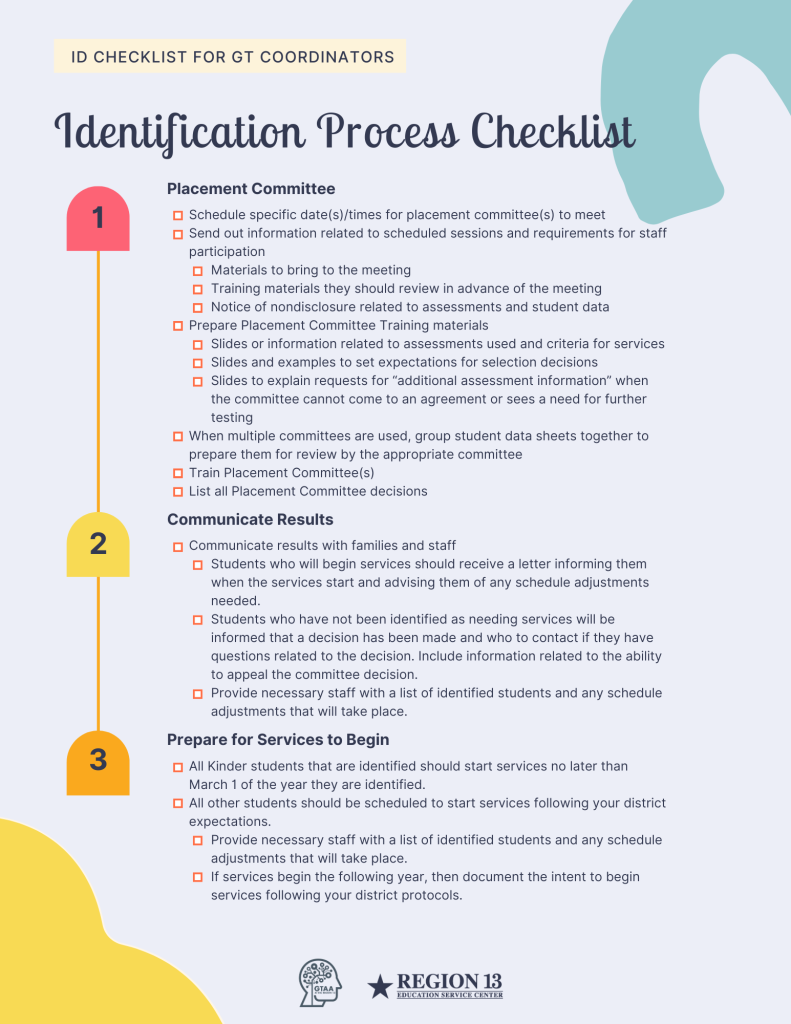
Conclusion
The identification and assessment process for Gifted and Talented (GT) students involves many steps. District coordinators must ensure they follow all the process requirements according to the Texas State Plan for Gifted/Talented Students as well as district rules. ESC Region 13’s checklists are available to help each district meet its programming needs.
Contact our team for additional leadership support opportunities and questions about Gifted and Talented program services. Subscribe to our monthly newsletter to stay up-to-date with the latest in GT, STEM, TEKS RS, and TExGUIDE, or read one of our recent blogs here.
Amber Reinecke is the Cross-Curricular Systems Program Manager and Gifted and Talented (GT) Specialist at ESC Region 13. She has experience as an elementary classroom GT teacher, as well as six years of experience as a Gifted and Talented Pull-out Teacher and Instructional Coach. She has a passion for working with the gifted community in order to advocate for student needs.






Add comment